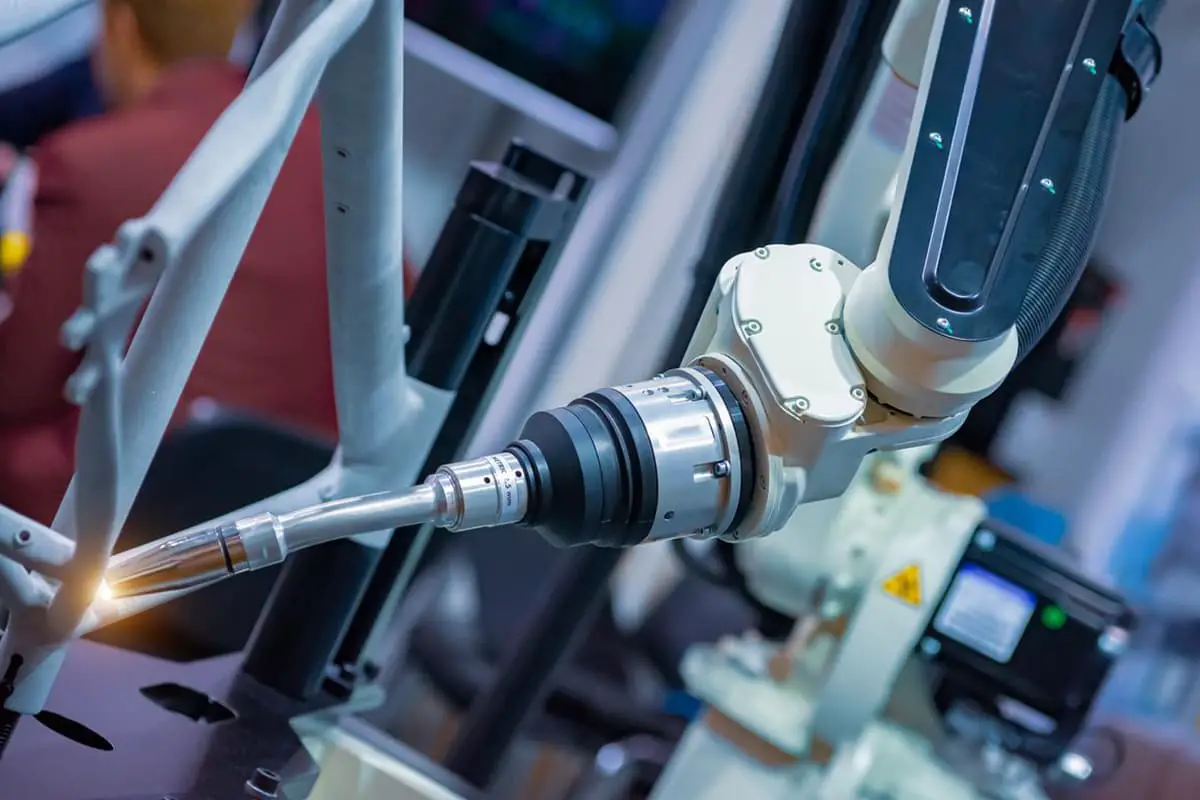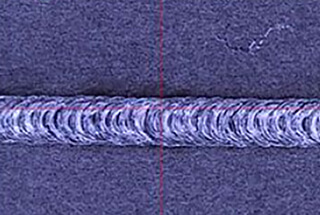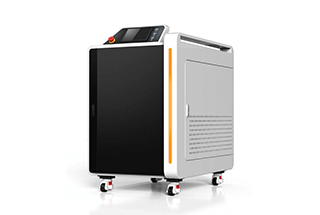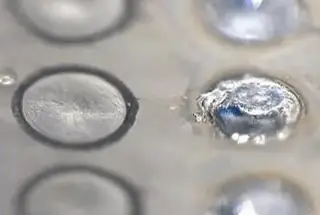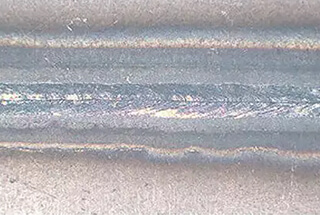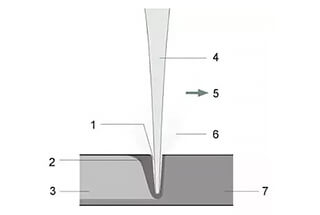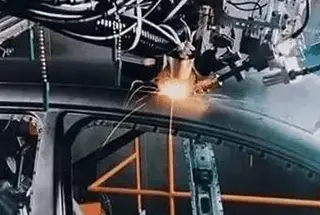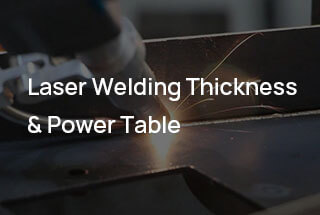
In the world of welding, choosing the right method can significantly impact efficiency and quality. Laser welding and TIG (argon arc) welding each offer unique benefits and drawbacks. Laser welding excels in speed, precision, and automation, making it ideal for intricate, high-volume applications. On the other hand, TIG welding is renowned for its versatility and ability to handle various metals with minimal distortion. This article explores these differences, helping you understand which welding technique best suits your needs and applications. Dive in to discover how these methods compare in terms of cost, efficiency, and practicality.
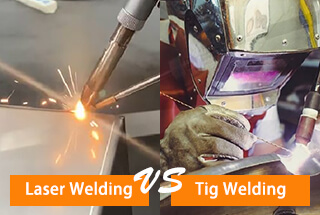
Laser welding is a high-precision joining process that uses a concentrated beam of light to melt and fuse materials, primarily metals or thermoplastics. This advanced technique delivers intense, localized heat to create strong, clean welds with minimal heat-affected zones.
The process involves focusing a high-power density laser beam onto the workpiece surface, causing rapid localized melting. As the beam moves along the joint, the molten material solidifies behind it, forming a strong metallurgical bond. This method is particularly effective for joining similar materials, though it can also be adapted for dissimilar metal welding with proper process control.
Various laser types are employed in welding applications, each with specific characteristics suited to different materials and joint configurations:
The key advantages of laser welding include:
At the molecular level, laser welding excites surface molecules, increasing their kinetic energy and fluidity. As these excited molecules interact and return to lower energy states, they form strong molecular bonds, creating a solid weld joint.
The evolution of laser welding technology has been closely tied to advancements in additive manufacturing, particularly metal 3D printing. While plastic-based 3D printing has been widely adopted, metal additive manufacturing presented unique challenges. Laser welding technology has enabled the rapid, precise fusion of metal powders, making metal 3D printing a viable and increasingly important manufacturing process.
This synergy between laser welding and additive manufacturing has accelerated the development and adoption of both technologies. As a result, laser welding has transitioned from a primarily experimental technique to a critical enabler of modern manufacturing processes, finding applications in industries ranging from automotive and aerospace to electronics and medical device manufacturing.
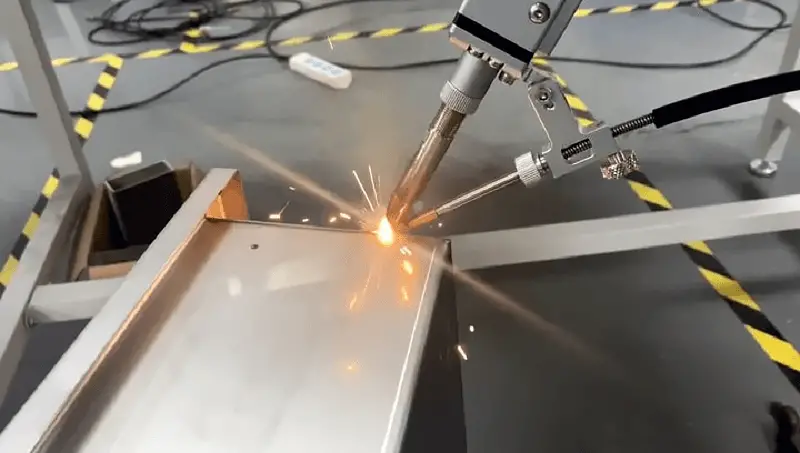
Laser welding harnesses the extremely high energy of focused laser beams to melt and fuse materials. When directed at a workpiece, the laser’s concentrated energy rapidly heats the targeted area, forming the basis of this advanced joining technology.
It’s crucial to note that laser light interacts with the workpiece surface. Excessively smooth surfaces can cause undesirable reflection, potentially reducing welding efficiency. Therefore, surface preparation may be necessary to optimize laser absorption.
The laser beam focuses intense energy on a precise point of the workpiece, causing localized melting. Upon cessation of laser action, the molten metal rapidly solidifies, creating a strong bond.
Laser welding techniques can be categorized based on beam output mode:
Additionally, weld formation characteristics define two primary types:
A key advantage of laser welding is its ability to achieve deep penetration with high depth-to-width ratios, reaching up to 12:1. This characteristic allows for strong, narrow welds in thick materials.
During the welding process, the laser rapidly injects heat into the material through a focused spot. The temperature rise rate is exceptionally high, enabling even deep subsurface material to reach high temperatures quickly. Penetration depth can be precisely controlled by adjusting the laser’s power density.
Laser welding systems typically employ CO2 lasers ranging from 1 to 4 kW. The generated beam is transmitted through a sophisticated optical system, including mirrors and focusing elements, to direct and concentrate the energy. Near the focal point, temperatures can reach 5000 to 20000 K, instantly melting the metal at the joint.
As the laser beam traverses the workpiece, the molten metal solidifies behind it, forming a continuous weld seam. This process effectively joins separate metal plates into a single unit.
The versatility of laser welding is evident in its material compatibility:
Laser welding is particularly advantageous for joining miniature, precise, densely arranged, and heat-sensitive components in valuable instruments. Its precision and minimal heat-affected zone make it superior to traditional welding methods in many high-tech applications.
While laser welding employs advanced technology, it can accommodate the same joint types as traditional welding methods, offering improved precision and control.
Resistance welding is used for welding thin metal products by clamping the welded workpiece between two electrical electrodes, melting the surface in contact with the electrical current to create a weld based on the hot resistance of the workpiece.
This welding method may cause the product workpiece to deform, as it is welded on both sides of the connector.
In contrast, laser welding is only carried out on one side, thus minimizing the risk of deformation.
Resistance welding requires frequent maintenance to eliminate metal oxides and other materials adhered to the product workpiece.
On the other hand, when laser welding a reinforcement lap connector made of thin metal material, it does not touch the product workpiece.
Moreover, laser welding allows light to enter areas that cannot be welded by basic welding, resulting in faster welding speed.
The use of non-power consuming and maintenance-free steam for welding thin product workpieces is common.
However, the welding rate of this method is relatively slow, and the thermal bonding is much larger than laser welding, which can easily cause deformation.
The arc welding speed is similar to that of argon arc welding, but it is slower than that of argon arc welding.
Electron beam welding relies on a beam to accelerate high-energy, high-density electrons to collide with the product workpiece. The main drawback of this method is that it requires high vacuum conditions to avoid electron scattering.
The machinery and equipment involved are complex, and the specification and appearance of the weldments are limited by the vacuum system.
Additionally, the installation quality of butt weldments must be strictly controlled.
Non-vacuum pump electron beam welding is possible, but the welding quality is often poor due to electron scattering, which affects the overall effectiveness.
Moreover, electron beam welding may have magnetic deviation and X-ray problems. The electronic devices may be affected by the electromagnetic field deviation, leading to malfunction or damage.
To address this issue, workpieces for electron beam welding products should be welded within a magnetic field. In contrast, laser welding does not require a vacuum system or demagnetization of the product workpiece before welding.
It can be performed in the air, making it suitable for operation on a production line or for welding permanent magnet materials.
When examining the advantages and disadvantages of laser welding technology, it is useful to compare it with traditional welding methods such as gas shielded welding and argon arc welding.
These classic welding methods are still widely used in the manufacturing industry, and it will take some time for laser welding to fully replace them.
Laser welding is particularly suitable for automated manufacturing. While it has been extensively used in 3D printing, it can also be applied in automating traditional welding tasks.
Automatic welding provides several benefits for manufacturers, such as increased convenience, higher product precision, and more stable quality.
Automated systems are also much faster than manual welders, and traditional welding still requires a large number of welders.
Wide range of compatible materials
In traditional welding, such as argon arc welding, converting from one material to another involves adjusting the flame temperature and arc strength.
The working principle of the laser is similar in this regard. The laser can adjust its power output to suit various materials, giving it a distinct advantage.
With preset parameters for different materials, laser welding is more convenient than other welding methods.
Thanks to its high power density, laser welding can weld materials that are challenging to weld using other technologies.
Laser welding can be applied to a wide range of materials, including super metals such as titanium and carbon steel.
In terms of power density, the only welding technology that can match laser welding is electron beam welding.
Fast heating rate
Another advantage of high power density lasers is their ability to melt materials faster than flame or arc welding. This results in faster welding speeds and stronger welds.
The depth of penetration in laser welding can be controlled by adjusting the power output of the laser.
Laser pulses can be applied to almost any material to prevent damage to both materials and equipment.
Complex geometry joints can be welded
One unique feature of laser welding is its ability to weld at a longer distance than other welding methods.
Laser-welded joints do not need to be in close proximity to the material being welded to provide the energy required for welding.
This provides more space for the operation of the workpiece and makes it possible to weld workpieces with complex geometries.
High safety
Laser welding machines are typically fully automatic and have a closed workspace. This means that personnel are no longer exposed to high temperatures and particles during welding.
On this point alone, a laser welding machine is worth investing in. Any technology that can improve workplace safety and keep people away from unnecessary hazards is worth considering.
There is a risk of cracking when the metal cools rapidly.
Anything that heats up quickly also cools down quickly. The same is true for laser welding. The localized transmission of energy through the laser means that the joints can be welded quickly.
However, this also means that the heat in the weld is dissipated rapidly through the material, which leads to significant thermal stress accumulation.
Only some materials can avoid cracking or damage due to this.
Carbon steel is a typical example, as it is prone to embrittlement when cooled too quickly.
The one-time investment of equipment cost is high
This may be the biggest obstacle to the wide application of this technology – the price of laser welding machines is expensive. This is more obvious than gas shielded welding and argon arc welding.
Traditional welding requires skilled welders, but does not necessarily require expensive equipment.
Laser welding overturns the idea that equipment is expensive, but operation does not require too many skills.
With the large-scale production, laser welding equipment will mature with the industrial chain. Like the early LED lighting industry, the price will become more affordable and widely used.
Traditional welding may complete its mission and become a part of history.
Tungsten Inert Gas (TIG) welding, also known as Gas Tungsten Arc Welding (GTAW), is an advanced arc welding process that utilizes a non-consumable tungsten electrode to produce the weld. This method generates an electric arc between the tungsten electrode and the workpiece, which heats and melts the base metal and, if used, the filler material, under the protection of an inert shielding gas.
During the TIG welding process, a continuous stream of inert gas flows from the welding torch nozzle, creating a protective atmosphere around the arc and weld pool. This gas shield effectively isolates the welding area from atmospheric contamination, preventing oxidation and other detrimental reactions that could compromise weld quality. The inert gas protection is crucial for preserving the integrity of the tungsten electrode, maintaining a stable arc, and ensuring the purity of the weld metal and heat-affected zone.
The choice of shielding gas significantly influences the welding characteristics and final weld quality. While pure argon is the most commonly used gas due to its excellent arc stability and cost-effectiveness, helium or argon-helium mixtures are also employed for specific applications. Helium provides higher heat input and deeper penetration, making it suitable for welding thicker materials or highly conductive metals like aluminum and copper. Argon-helium mixtures offer a balance between the arc stability of argon and the increased heat input of helium, allowing for optimized welding performance across various materials and thicknesses.
Related reading: MIG vs TIG Welding
Tungsten Inert Gas (TIG) welding, also known as Gas Tungsten Arc Welding (GTAW), is an advanced arc welding process that utilizes a non-consumable tungsten electrode and an inert shielding gas to protect the weld pool. This method offers exceptional control over the welding process, resulting in high-quality, precise welds with minimal spatter and distortion.
Key advantages of TIG welding include superior visibility of the arc and molten pool, facilitating precise control and high-quality results. The process produces minimal to no slag, eliminating post-weld cleaning requirements and reducing the risk of inclusions. However, when performing outdoor operations, special windshield measures are necessary to maintain the integrity of the shielding gas envelope.
Gas-shielded welding processes can be categorized into two main types based on electrode consumption:
In TIG welding, argon is the most commonly used shielding gas due to its cost-effectiveness and wide availability. Hence, the process is often referred to as “argon arc welding.” Helium can also be used as a shielding gas, offering higher heat input and potentially faster welding speeds, but its higher cost limits its widespread adoption.
For specialized applications, small amounts of hydrogen may be added to the shielding gas mixture to enhance weld penetration and cleaning action. However, this practice requires careful consideration of material compatibility and potential risks of hydrogen embrittlement.
The versatility of TIG welding makes it ideal for joining a wide range of metals, including aluminum, stainless steel, and exotic alloys, particularly in applications requiring high precision and aesthetic appeal.
TIG (Tungsten Inert Gas) welding is classified into three categories based on the level of automation: manual, semi-automatic, and automatic welding.
Manual TIG welding requires the operator to control both the welding torch movement and filler wire addition entirely by hand. This method offers maximum flexibility and is widely used for complex or precision welding tasks.
Semi-automatic TIG welding combines manual torch manipulation with automated wire feeding. The operator guides the torch while a mechanized system feeds the filler wire at a preset rate. This method enhances consistency in filler metal deposition but is less commonly employed.
Automatic TIG welding systems offer the highest level of mechanization. In fixed-workpiece configurations, the welding torch is mounted on a motorized carriage that traverses the joint. Filler metal can be added using either cold wire or hot wire feeding techniques. Hot wire feeding pre-heats the filler material electrically, increasing deposition rates and improving productivity.
It’s worth noting that some TIG welding applications, particularly thin sheet welding or root passes, may not require filler metal addition at all, relying solely on the fusion of the base materials.
Among these methods, manual TIG welding remains the most versatile and widely adopted, especially in industries requiring high-precision welds or complex joint geometries. Semi-automatic TIG welding, while offering some advantages, has found limited application in specific niche processes.

For some important thick-walled components, such as pressure vessels and pipes, made of black and non-ferrous metals, TIG welding is sometimes used to ensure high welding quality.
Tungsten argon arc welding is used in root penetration weld bead connection, all position welding, and narrow gap connection.
| Category / mode | Argon arc welding | Laser welding |
| Deformation | Easy to deform | Slight deformation or no deformation |
| Aesthetic degree | Unsightly and needs repeated polishing | The appearance is smooth and can be treated slightly |
| Weld spot size | Large weld spot | Fine weld spot and adjustable spot |
| Shielding gas | Argon | Argon |
| Heat input | High heat | Low heat |
| Machining precision | Commonly | Precise |
| Processing hours | Time consuming | Short time consuming |
| Security | Ultraviolet light, radiation hazard | T exposure to light, almost no harm |
| Perforation degree | Easy perforation | Not easy to pierce |
| Degree of automation | Very low | Commonly |
The spot welding machine and automatic welding are simply used for classification.
The welding operation of a laser spot welding machine is simple and fast.
The operation of non-melting electrode argon arc welding is relatively difficult and requires consumables, so the welding speed is relatively slow.
The welding speed of an automatic laser welding machine and an automatic MIG welding machine is not very different because MIG welding still needs molten wire, so the welding speed will be slightly slower than that of an automatic laser welding machine.
A laser welding machine is used to melt weld materials using a laser, but laser deep welding is not its strong suit. It’s not that laser deep welding is not good, but the cost is too high.
For example, if you need to weld a 2.0mm stainless steel plate, you would need to use a 500W optical fiber transmission laser welding machine at a minimum, and the price would be about 100000.
While a general argon arc welding machine can weld such a thick stainless steel plate, the price is only a few hundred, and automatic argon arc welding costs twenty or thirty thousand.
Therefore, it is not cost-effective to use a laser welding machine if deep penetration is required for welding thick materials.
The welding appearance of a laser spot welding machine is more beautiful than that of argon arc welding with a non-melting electrode.
The welding appearance of an automatic laser welding machine is similar to that of an automatic argon arc welding machine, and the laser welding of thin materials is better.
In terms of welding firmness, as long as the power of the laser welding machine is large enough, it can weld firmly, which is comparable to argon arc welding.
However, the heat of the laser welding machine is more concentrated, and the thermal deformation of the material is smaller, so the laser welding machine has more advantages in welding thin-walled materials.
In terms of precision, the precision of the laser welding machine is higher, and subsequent welding using a laser welding machine basically does not require processing, which saves time and effort.
The operation of a laser spot welding machine is much less difficult than that of non-melting electrode argon arc welding.
In fact, argon arc welding requires skill and is prone to errors, but laser welding is much simpler, and the operation is more straightforward.
Even if there are errors, they are not significant.
The operation of automatic laser welding and automatic argon arc welding is not difficult. Both of them require computer control.
For welding thin-walled materials, it is better to use a laser welding machine than to weld thick materials.
If there are no high requirements for welding speed and accuracy, it is more cost-effective to use an argon arc welding machine.
However, if cost is not a concern, it is better to use a laser welding machine.
Compared with traditional arc welding, handheld laser welding machine can save about 80% ~ 90% of electric energy and reduce the processing cost by about 30%.
Laser handheld welding can complete the welding of dissimilar steel and dissimilar metals. It has a fast welding speed, small deformation, and a small heat-affected zone.
The welds should be beautiful, flat, and free from or with very few pores and contamination. Hand-held laser welding machines can perform micro open parts and precision welding.
During laser hand-held welding, the heat input is low, and the deformation of the workpiece is small, which can result in a beautiful welding surface without or with only simple treatment (depending on the required welding surface effect).
Hand-held laser welding machines can greatly reduce the labor cost of the extensive polishing and leveling process.
Advantages of handheld optical fiber welding machine over traditional argon arc welding
| Item | Handheld optical fiber laser welding | Traditional argon arc welding |
| Employment cost | The operation is simple, ordinary people start it in half an hour, and the employment cost is low | Recruitment is difficult, wages are high and employment costs are high |
| Personal injury | Pure single wavelength beam energy, low indirect radiation, only need protective glasses to filter strong light | Occupational disease, serious physical injury |
| Efficiency | The speed is fast, the efficiency can reach 3-8 times that of argon arc welding, and the linear welding speed can reach more than 10cm / s | Slow speed and low efficiency |
| Thermal deformation | Energy concentration and little influence of thermal deformation | Large thermal influence and deformation |
| Weld quality | The weld is fine and beautiful, the solution pool is deep and the strength is high | The weld is rough and irregular, which needs secondary grinding and polishing |
| Weldable material | Very thin materials can be welded, such as 0.05mm stainless steel | Do not weld too thin material |
| Learning difficulty | Ordinary people can get started in half an hour, and inexperienced women workers can also get started | Professional welders are required, and the technical threshold is high |
| Consumables | It can be welded with filler wire or without welding wire | Consumables, welding wire required |
| Weld damage | The weld is beautiful and fine, the solution pool is uniform and the consistency is good. | It is easy to weld through if there are pores |
Compared with traditional argon arc welding, handheld optical fiber welding machine has disadvantages
| Item | Handheld optical fiber laser welding | Traditional argon arc welding |
| Gap filling ability | Weak, our company adopts swing welding, which can fuse the gap of 0.3-0.5mm at most, and adopts wire feeding welding, which can fuse the gap of more than 1mm at most | Strong, insensitive to workpiece gap, large gap can be welded through filler |
| Equipment price | Expensive equipment | Cheap equipment |
| Volume weight | Relatively large volume and weight | Small size and light weight |
| Thick plate welding | It is not conducive to the welding of thick plate materials. The penetration capacity of 1000 Watt molten pool is about 3mm and 1500 Watt is about 4mm. | Thick plate material welding has advantages, which can accumulate and fill the welding solution pool, and can adapt to the welding of thicker materials |
Advantages of handheld optical fiber welding machine over traditional argon arc welding
| Item | Handheld optical fiber laser welding | Traditional argon arc welding |
| Employment cost | The operation is simple, ordinary people start it in half an hour, and the employment cost is low | Recruitment is difficult, wages are high and employment costs are high |
| Personal injury | Pure single wavelength beam energy, low indirect radiation, only need protective glasses to filter strong light | Occupational disease, serious physical injury |
| Efficiency | The speed is fast, the efficiency can reach 3-8 times that of argon arc welding, and the linear welding speed can reach more than 10cm / s | Slow speed and low efficiency |
| Thermal deformation | Energy concentration and little influence of thermal deformation | Large thermal influence and deformation |
| Weld quality | The weld is fine and beautiful, the solution pool is deep and the strength is high | The weld is rough and irregular, which needs secondary grinding and polishing |
| Weldable material | Very thin materials can be welded, such as 0.05mm stainless steel | Do not weld too thin material |
| Learning difficulty | Ordinary people can get started in half an hour, and inexperienced women workers can also get started | Professional welders are required, and the technical threshold is high |
| Consumables | It can be welded with filler wire or without welding wire | Consumables, welding wire required |
| Weld damage | The weld is beautiful and fine, the solution pool is uniform and the consistency is good. | It is easy to weld through if there are pores |
Disadvantages of handheld optical fiber welding machine over traditional argon arc welding
| Item | Handheld optical fiber laser welding | Traditional argon arc welding |
| Gap filling ability | Weak, our company adopts swing welding, which can fuse the gap of 0.3-0.5mm at most, and adopts wire feeding welding, which can fuse the gap of more than 1mm at most | Strong, insensitive to workpiece gap, large gap can be welded through filler |
| Equipment price | Expensive equipment | Cheap equipment |
| Volume weight | Relatively large volume and weight | Small size and light weight |
| Thick plate welding | It is not conducive to the welding of thick plate materials. The penetration capacity of 1000 Watt molten pool is about 3mm and 1500 Watt is about 4mm | Thick plate material welding has advantages, which can accumulate and fill the welding solution pool, and can adapt to the welding of thicker materials |
Table 3: handheld laser welding has obvious advantages over traditional argon arc welding
| heat effect | subsequent treatment | requirements for plates | requirements for workers | welding speed | availability of consumables | |
| Argon solitary glow | great | need | Thickness > 1mm | High, usually requires professional technicians (assuming that the salary of professional technicians is 10000 yuan / month) | slow | Yes (flux, welding wire) |
| Handheld laser welding | Very small | unwanted | Thickness < 3mm | Low, ordinary workers can get started after simple training (assuming that the salary of ordinary workers is 4000 yuan / month) | It is 2-10 times that of argon arc welding | nothing |

The debate between traditional argon arc welding and laser welding continues in the manufacturing industry, reflecting the rapid and often unpredictable pace of technological advancement.
Experienced argon arc welding operators, with decades of expertise, may face challenges adapting to laser welding technology due to significant differences in operation and process control.
Both welding methods offer distinct advantages and limitations. The optimal choice depends on specific industrial requirements, material properties, production volume, and quality standards.
Cost Considerations:
Traditional argon arc welding machines typically range from 2,000 to 5,000 CNY, making them accessible to both large-scale manufacturers and small workshops. Their compact, lightweight design facilitates on-site welding operations and enhances portability.
However, argon arc welding has limitations:
Laser Welding Advantages:
Laser welding systems, while more expensive (50,000 to 100,000 CNY), offer significant benefits:
Laser systems are particularly suited for high-volume production environments, automated manufacturing lines, and applications requiring precise, repeatable welds. However, their size and cost may limit their applicability in small-scale or mobile operations.
The choice between these technologies should be based on a comprehensive analysis of production requirements, material characteristics, quality standards, and long-term operational costs, including factors such as energy efficiency, maintenance needs, and workforce availability.

